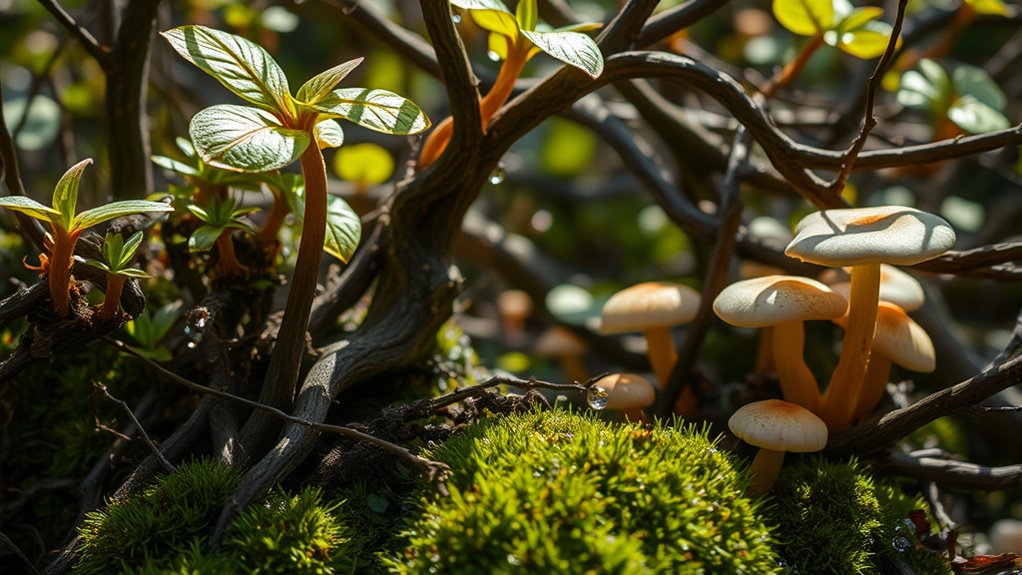Wild plants are rich in myths and superstitions, believed to hold protective, healing, and magical powers. For example, the hazel tree symbolizes wisdom, while foxglove is linked to fairy magic and caution due to its toxicity. Elder trees and hawthorn are sacred, representing protection, fertility, and renewal, often woven into festivals and rituals. Famous guardians like Thor and the Green Man embody divine strength and renewal. Explore further to uncover more fascinating tales and beliefs surrounds wild plants.
Key Takeaways
- Many wild plants, like foxglove, are linked to fairy and witchcraft lore, believed to ward off evil spirits or attract magical aid.
- Elder trees are considered protectors and symbols of renewal, with harvesting without permission believed to anger spirits like the Elder Mother.
- Hawthorn branches are used in rituals for love and protection, with superstitions warning against bringing blooming hawthorn indoors.
- Mythological guardians such as Thor and Hermes symbolize protection and divine connection, often associated with sacred trees and plants.
- Superstitions hold that planting wildflowers during specific lunar phases or weather conditions can influence growth and bring good luck.
The Sacred Wisdom of the Hazel Tree
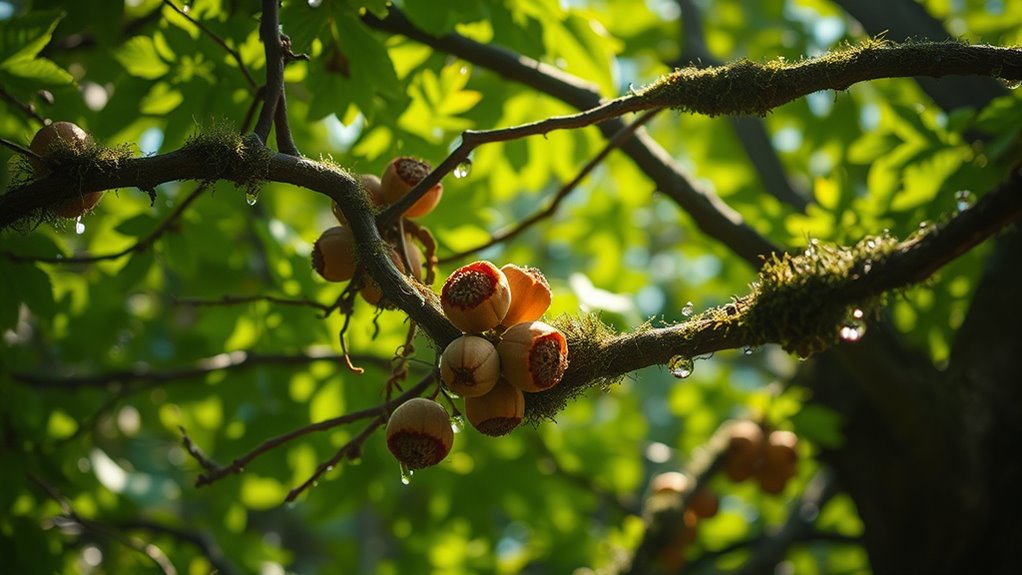
The hazel tree holds a special place in many ancient cultures, especially within Celtic lore, where it symbolizes wisdom and inspiration. You’re believed to gain magical powers by consuming its nuts, which are linked to poetic and prophetic abilities. Its significance is also reflected in Halloween, where symbols of nature and mystical elements are prevalent in various traditions. In Celtic mythology, the hazel is central at the Well of Wisdom, representing divine knowledge and insight. Its nuts are thought to disclose hidden truths, making them highly prized by druids and sages. Additionally, the symbolic importance of the hazel extends to its use in divination and ritual practices across different cultures. Norse mythology also venerates the hazel as the Tree of Knowledge, sacred to Thor, while Romans associate it with Mercury, emphasizing communication and wisdom. The tree’s mystical reputation extends to folklore, where hazelnuts are used to enhance creativity and spiritual growth, reinforcing its status as a symbol of authority and divine understanding. Moreover, the psychological aspects of dreaming are sometimes linked to the symbolic meanings attributed to the hazel, suggesting its role in fostering intuition and insight. Recent studies on plant symbolism reveal how deeply intertwined the hazel’s mythological significance is with human consciousness and spiritual practices. Understanding the cultural symbolism of the hazel can deepen one’s appreciation of its role in various spiritual traditions.
Foxglove: Fairy and Witch Connections

Foxglove has long been entwined with fairy and witchcraft lore, serving as a powerful symbol in folklore and mystical practices. You might collect dew from its flowers to communicate with fairies or place foxgloves around cradles to ward off fairy bewitchment.
The plant’s reputation as a favorite of fairies makes picking it unlucky, and fairies are said to live inside its bell-shaped blooms. Folklore also suggests the spots inside the flowers are fairy handprints, remnants of fairy aid in making gloves. These stories are reinforced by its cultural significance in various traditions, emphasizing its mystical importance. Some traditions also associate foxglove with magical protection, highlighting its role in warding off evil spirits. Its toxicity further underscores its dangerous reputation in folklore, symbolizing the fine line between healing and harm, as many believed that touching or ingesting it could have both magical and deadly consequences. Additionally, the plant’s biological properties have contributed to its mystical reputation, as its potent compounds were historically thought to possess both healing and destructive powers.
Sage as a Blessing and Healing Plant
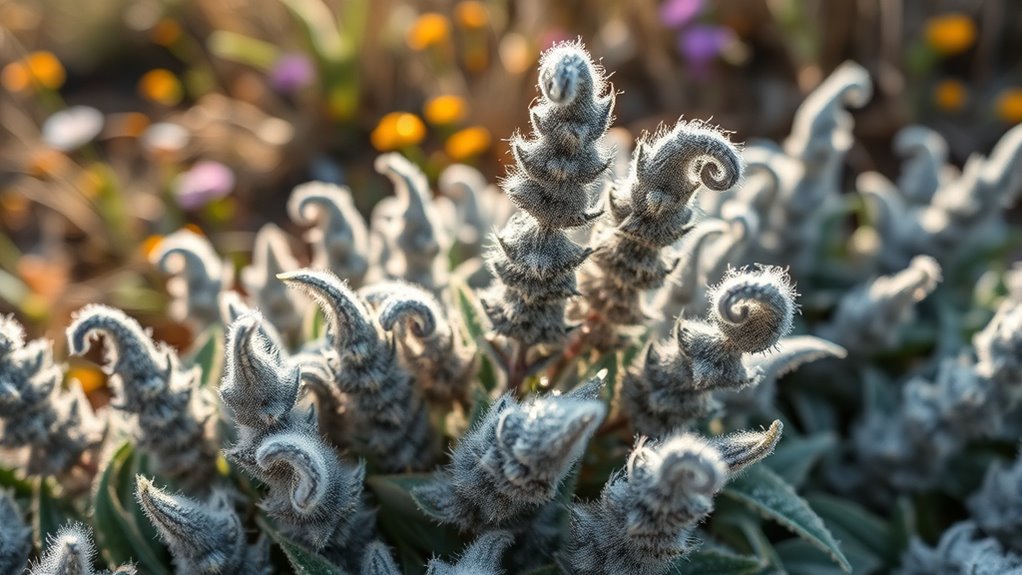
Sage has long been cherished not only for its mystical significance but also for its powerful healing properties. It’s packed with antioxidants like caffeic, chlorogenic, and rosmarinic acids that can help lower cancer risks and boost brain function.
Traditionally, you’ve used sage for pain relief, digestive health, and to protect against infections thanks to its antimicrobial effects. Its essential oils—camphor, α-terpineol, and linalyl acetate—offer antibacterial, antifungal, and anti-inflammatory benefits.
Sage also improves memory and brain health, making it a valuable herbal remedy. In many cultures, sage symbolizes wisdom and longevity, used in rituals for purification and protection.
Its rich vitamin and mineral content further supports your overall health, making sage a potent herb for healing and blessings.
Elder Tree and the Spirit of the Elder Mother
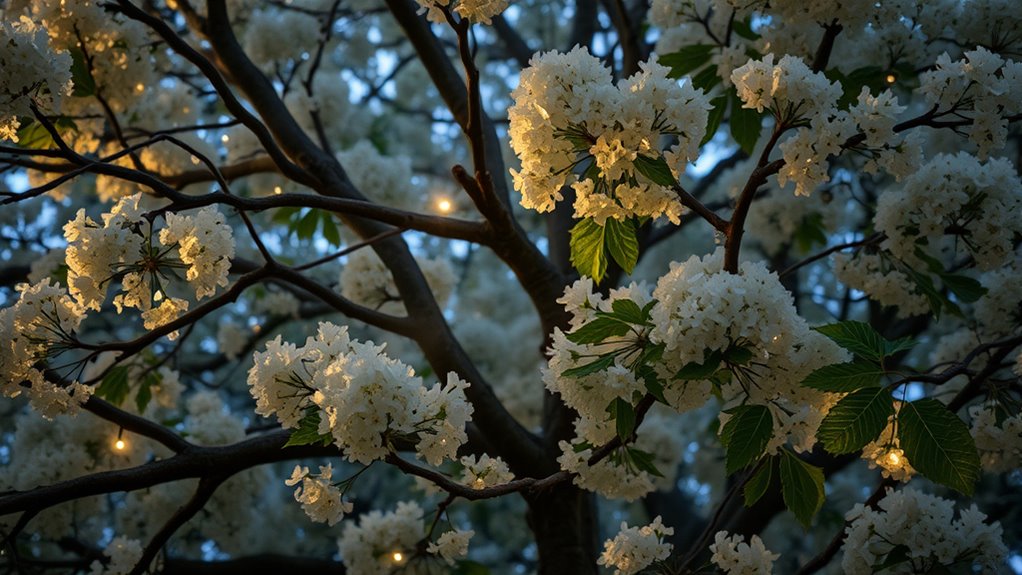
Elder trees hold a special place in folklore as protectors and symbols of renewal, often placed near homes to ward off evil spirits and lightning. You’d see self-sown elder trees as especially auspicious, deserving protection because of their fast growth and regenerative qualities. These qualities also make elder trees valuable in diversification strategy for natural environments, further emphasizing their importance in ecosystems.
In Scandinavian stories, the Elder Mother, Hyldemöer, is a guardian figure embodying wisdom and magic, linked to protection and life cycles. Harvesting elder wood without permission was believed to anger her, emphasizing respect for the tree’s sacred power. The medicinal properties of elder trees further reinforced their revered status in traditional healing practices.
Elder trees also kept witches away and were used in rituals for divination and healing. Their connection to festivals like Samhain highlights their role in marking life’s transitions, symbolizing regeneration and the spiritual bridge between worlds. The spiritual energy associated with elder trees, called Mana, further underscores their protective and regenerative significance in various cultural traditions. Additionally, the cultural significance of elder trees is reflected in their role as symbols of continuity and spiritual protection across different societies.
Furthermore, integrating elder trees into holistic health practices exemplifies their enduring role in fostering community well-being and spiritual harmony.
Hawthorn: Fertility, Fear, and Festivals
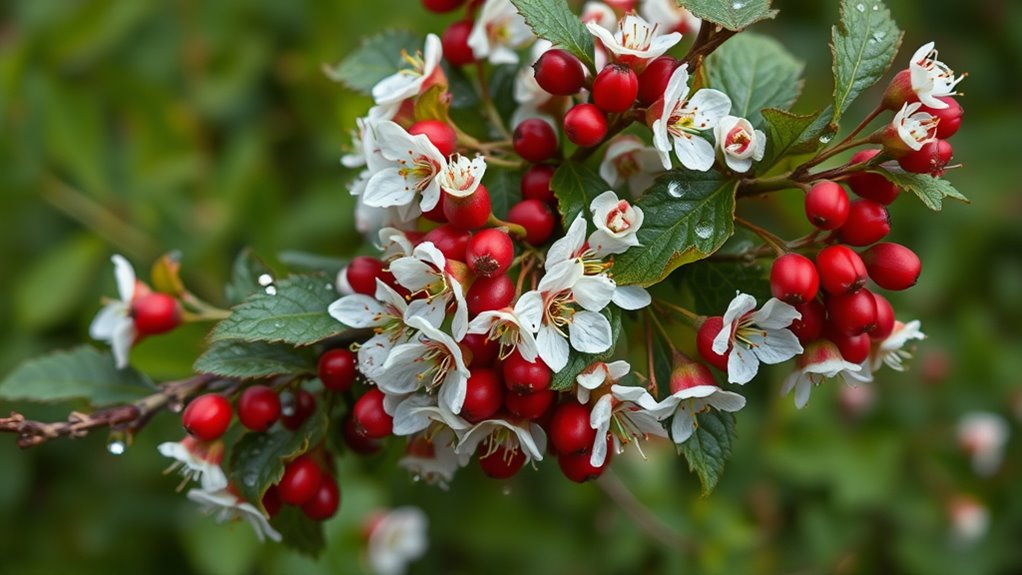
Hawthorn trees have long been woven into the fabric of European folklore, symbolizing both love and protection. You might’ve seen crowns of hawthorn flowers worn by women seeking a mate or used in fertility rituals during Beltane, marking spring’s arrival. Its musky scent is linked to sensuality and attraction, reinforcing its association with love and fertility. Additionally, many traditional practices emphasize embracing kindness and compassion when interacting with nature, fostering a respectful relationship with these sacred trees. Yet, many superstitions warn against bringing a blooming hawthorn into your home, fearing it could bring illness or bad luck. Celtic stories caution against lingering alone under the tree, fearing fairy abduction. During May Day celebrations, villagers bring hawthorn branches for blessings and fertility. Hanging hawthorn branches above doorways is believed to ward off evil spirits, blending its protective powers with its role in marking life’s cycles. Some beliefs also suggest that respecting nature’s sacredness can enhance the positive effects attributed to hawthorn and similar plants. In addition, modern research highlights the importance of AI safety in preserving the integrity of cultural folklore and traditional practices, ensuring they are protected amidst technological advancements. Exploring dream symbols related to plants like hawthorn can deepen understanding of their spiritual significance and cultural meanings.
Planting Superstitions: Do’s and Don’ts
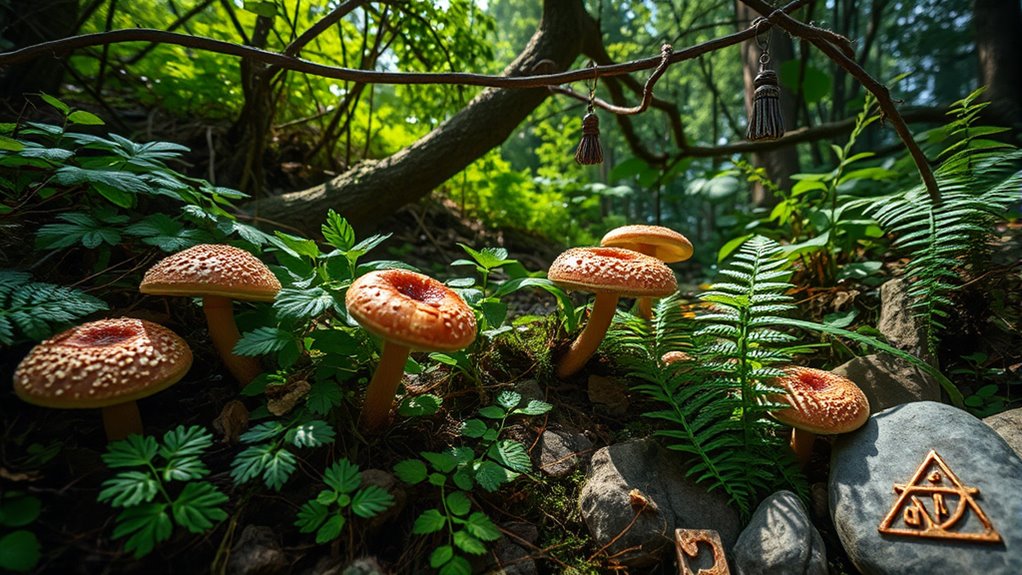
When it comes to planting, superstitions often guide the best times and conditions to guarantee success. You should plant when the soil is warm enough to sit on without your pants, signaling ideal conditions. Align planting with specific moon phases if you believe it boosts growth, and choose favorable weather, like right after rain, to ensure good luck. According to traditional beliefs, the best planting days are often determined by lunar cycles, which some gardeners use to enhance crop yields. Observe nature—plant when birds sing or trees leaf out—these signs are believed to bring prosperity. Speaking softly or singing to your plants is thought to encourage healthy growth, while dancing or stomping near them can bring good fortune. Avoid saying thank you, as some believe it might hinder their progress. Plant in sheltered areas or around protective species to ward off pests and evil spirits, and choose plants like basil or sage for added protection. Additionally, understanding cultural intelligence can help gardeners interpret and respect different superstitions across cultures, enriching their gardening practices. Recognizing traditional symbols can also guide planting decisions, helping to attract positive energies and ward off negative influences. Incorporating knowledge of dog breeds can also inspire gardeners to select plants that attract specific beneficial insects or animals, enhancing garden health and balance. Furthermore, some believe that planting during certain moon phases influences the vitality and success of your garden, so timing can be crucial for desired outcomes.
Mythological Guardians: Thor, Hermes, and the Green Man

Throughout history, mythological guardians like Thor, Hermes, and the Green Man have symbolized protection, renewal, and divine connection in various cultures.
Mythological guardians embody protection, renewal, and divine connection across cultures throughout history.
Thor, linked to lightning and strength, protects humans and is associated with sacred oak and rowan trees, which symbolize power and safety. Research shows that sacred trees have often been considered living guardians, believed to harbor divine spirits that safeguard communities and natural environments. These trees are also known for their cultural significance, representing the enduring relationship between nature and spirituality.
Hermes, the Greek messenger, guides souls and embodies wisdom, often depicted with a hazel staff, representing insight and protection.
The Green Man symbolizes renewal and fertility, acting as a guardian of nature and seasonal rebirth. Sacred trees like oak, rowan, and hazel serve as symbols of divine protection and spiritual connection.
These figures and plants reflect an ancient understanding of nature’s protective and nurturing qualities, emphasizing their importance in myth, folklore, and spiritual practices.
Elder and Hawthorn in Ancient Healing Practices
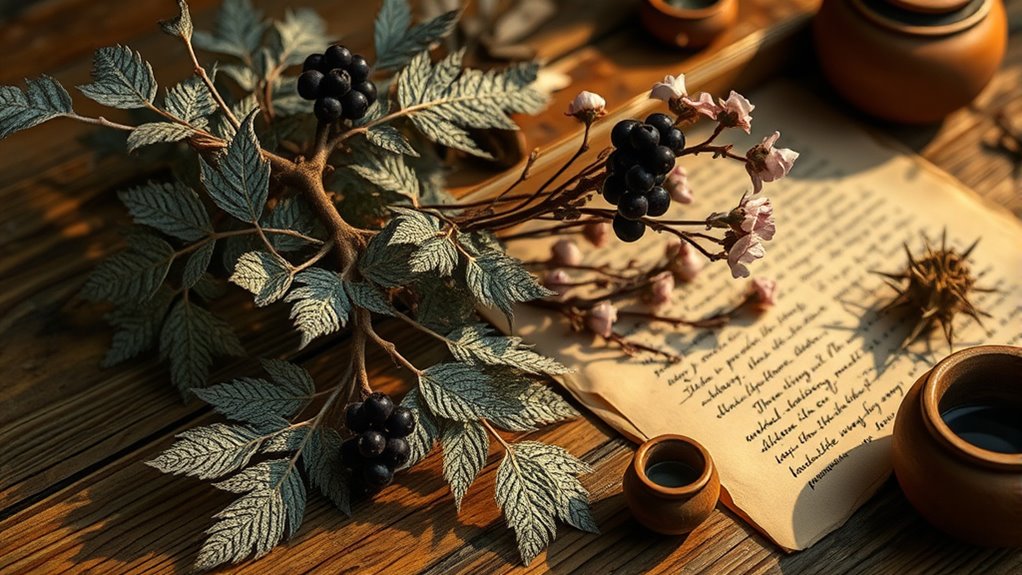
Ancient cultures recognized the powerful healing and protective qualities of elder and hawthorn trees, integrating them into rituals and medicinal practices. Hawthorn, in particular, was valued for its ability to heal both physical and emotional heart wounds.
Its thorns symbolized protection, creating energetic shields against negative influences, and were used to craft tools like fish hooks and sewing awls.
The berries and flowers of elder trees served in remedies for colds and pneumonia, while the tree itself was seen as sacred, offering spiritual protection.
Elder also represented wisdom and longevity, often linked to spirits and fairies, and used in rituals to ward off evil.
Both trees symbolized protection, yet hawthorn focused more on heart healing, blending medicinal benefits with spiritual symbolism.
Folklore and Cultural Significance of Wildflowers
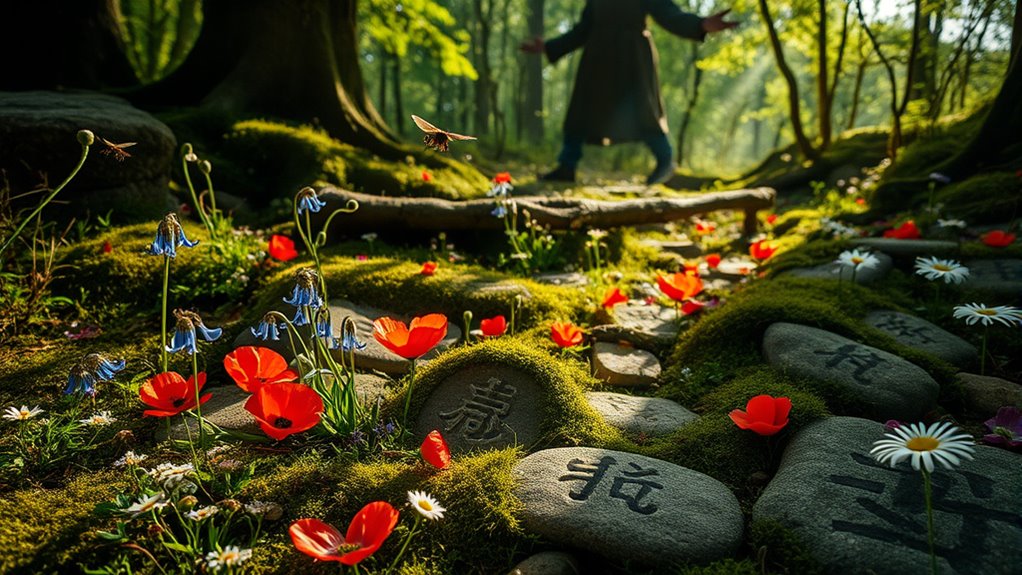
Wildflowers hold a special place in folklore and cultural traditions around the world, symbolizing hope, renewal, and connection to nature.
In European stories, dandelions represent wishes and new beginnings, while Lady’s Bedstraw is linked to easy childbirth and mythological goddesses like Frigg.
Many wildflowers feature in legends reflecting cultural and historical events, shaping their symbolism. For example, Indian Blanket flowers are tied to Native American stories and Spanish conquests, considered lucky or sacred in some cultures.
Their traditional uses often blend medicinal and magical beliefs, like dandelions’ diuretic properties.
These stories influence how societies view wildflowers, embedding their symbolism in rituals and customs.
As you explore, you’ll find that wildflowers serve as living symbols of hope, history, and cultural identity.
Historical Beliefs and Cautions Surrounding Wild Plants
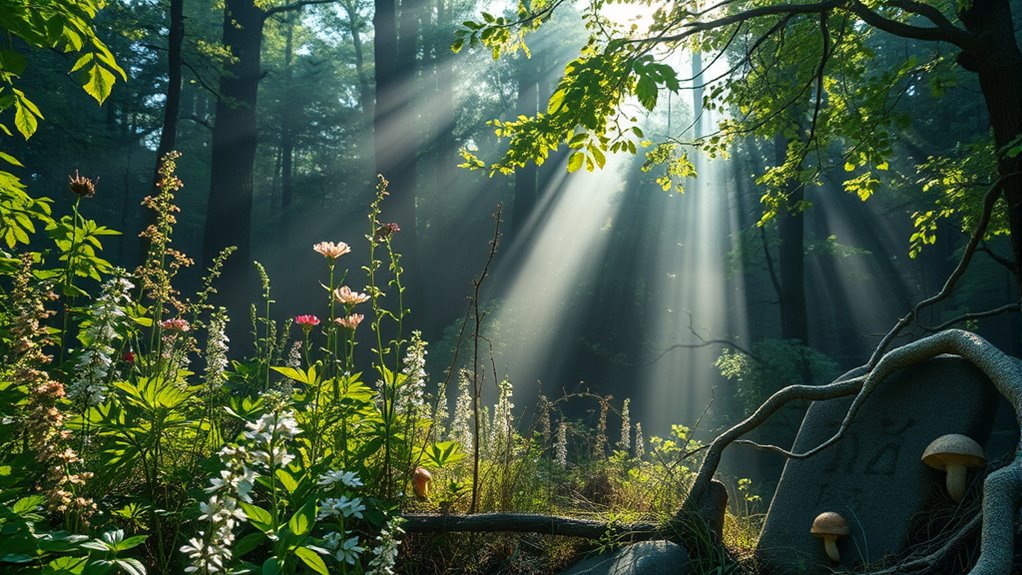
People have long held beliefs about wild plants that blend reverence with caution, shaping how societies use and respect these natural resources. Ancient cultures viewed many plants as spirits, incorporating them into rituals and ceremonies, which fostered sustainable harvesting practices.
For example, Indigenous groups like the Salish combined spiritual respect with practical use, ensuring plants remained available for future generations. Folklore often included warnings based on the plants’ properties, such as the European nickname “pissabed” for dandelions, warning of their diuretic effects.
These stories served as practical advice, highlighting both benefits and dangers. Overharvesting and land use changes also taught early societies about the importance of preserving wild habitats, emphasizing a cautious approach rooted in traditional knowledge.
Frequently Asked Questions
Are There Specific Times to Plant Certain Wild Herbs for Luck?
You wonder if specific times matter when planting wild herbs for luck. Traditionally, some herbs like parsley are best planted on Good Friday at 3 PM, symbolizing the Crucifixion.
Others, like fennel, are planted whenever you’re inspired, as they bring good fortune naturally. While superstitions link planting times to luck, focusing on planting during favorable weather and seasons often yields better results.
Can Picking Wild Plants Without Knowledge Be Dangerous or Cursed?
Picking wild plants without knowledge can be dangerous because many look alike, and some are toxic or cause skin reactions. You might mistakenly handle or consume poisonous species, risking illness or severe allergic responses.
While curses aren’t real, the real danger lies in misidentification and improper handling. To stay safe, always learn about plants beforehand, use reputable guides, and seek advice from experts before foraging.
Do Superstitions About Plants Vary Across Different Cultures?
You’ll find that superstitions about plants do differ widely across cultures. In some societies, certain plants are seen as symbols of protection or luck, while in others, they’re linked to bad omens or taboos. These beliefs often stem from history, mythology, or regional folklore, shaping how you might interact with plants.
Recognizing these differences helps you understand the cultural significance and respect local traditions when dealing with wild plants.
How Did Ancient Societies Incorporate Wild Plants Into Their Rituals?
You might think plants are just for decoration, but ancient societies used wild plants like Vervain and Mistletoe as powerful tools in their rituals—like magical, life-saving weapons!
They offered these plants to gods, used them to protect and purify sacred spaces, and believed they could bridge worlds. These plants weren’t just symbols; they were essential, mystical ingredients for connecting humans with divine forces and ensuring prosperity.
Are There Modern Practices That Respect Traditional Plant Folklore?
You can see modern practices that respect traditional plant folklore in many ways. You might incorporate herbal lore into your garden, honoring seasonal harvesting and ecological rhythms.
Respect sacred plants through rituals or ceremonies, and choose diverse species to promote biodiversity.
Conclusion
As you explore these wild plants, remember they’re both sacred and misunderstood—guardians of ancient wisdom and symbols of nature’s mysteries. While they’re celebrated in folklore, beware of their hidden dangers, like shadows lurking behind delicate blooms. Like a gentle breeze that can turn into a storm, these plants remind you to respect their power, balancing reverence with caution. In nature’s quiet beauty, danger and wonder walk hand in hand.

